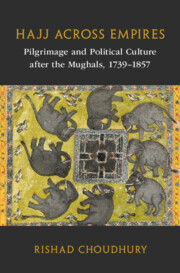Book contents
- Hajj across Empires
- Asian Connections
- Hajj across Empires
- Copyright page
- Dedication
- Epigraph
- Contents
- Figures
- Maps
- Tables
- Preface and Acknowledgments
- Note on Transliterations and Translations
- Abbreviations
- Maps
- Introduction
- Part I Departures
- 1 Pilgrim Passages
- 2 The Hajj Bazaar Economy
- Part II Crossings
- Part III Returns
- Bibliography
- Index
- Asian Connections
2 - The Hajj Bazaar Economy
from Part I - Departures
Published online by Cambridge University Press: 01 February 2024
- Hajj across Empires
- Asian Connections
- Hajj across Empires
- Copyright page
- Dedication
- Epigraph
- Contents
- Figures
- Maps
- Tables
- Preface and Acknowledgments
- Note on Transliterations and Translations
- Abbreviations
- Maps
- Introduction
- Part I Departures
- 1 Pilgrim Passages
- 2 The Hajj Bazaar Economy
- Part II Crossings
- Part III Returns
- Bibliography
- Index
- Asian Connections
Summary
Chapter 2 examines the economic life of the South Asian hajj, which, drawing on contemporary conceptualizations, it describes as a “bazaar” economy. The chapter suggests that this seaborne economy, whose lynchpin was the seasonal market of the hajj, was an important arena for speculative ventures from the Subcontinent, particularly from the western seaboard of India. At the same time, the chapter underlines how major developments in Indian Ocean bazaar trade during the eighteenth century – the growth of the cash nexus, the deepening of credit networks, and the proliferation of new patterns of consumption and production – invigorated an array of South Asian gift-giving practices during hajj. By examining both merchant inventories and gift registers, the chapter argues that, far from being located outside the realms of commodity exchange, the gift was intricately interwoven into the hajj bazaar economy. From religiously inspired altruism to politically motivated exchange, hajj gifts thus also played a role in invigorating the prestige of emergent royal and other social groups in India as the Mughal empire decentralized. Like the previous chapter, Chapter 2 also explores matters over the long durée. It accordingly shows how colonial expansion ultimately recast the meanings of both the gift and the “bazaar.”
- Type
- Chapter
- Information
- Hajj across EmpiresPilgrimage and Political Culture after the Mughals, 1739–1857, pp. 68 - 108Publisher: Cambridge University PressPrint publication year: 2024



